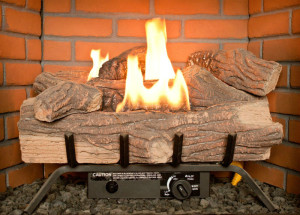Whether you’re trying to choose a new heating appliance or are debating updating an existing one, choosing the right fireplace for your family can be difficult. With so many different styles available – as well as more choices in fuel sources than ever before – now is the perfect time to find a new fireplace for your family.
The following is a direct comparison between two of the most common fireplace choices: inserts and open hearth fireplaces. With pros and cons to both appliances, this comparison can help you make a decision when it comes to choosing a fireplace.
Efficiency
- Inserts: Wood burning inserts are designed to help radiate heat back into the room as well as burn more efficiently. Modern EPA certified wood burning inserts are between 60 and 80% efficient. The efficiency rating for inserts of other fuel sources such as pellets or gas are even higher.
- Open fireplaces: While few things can beat the look and feel of an open hearth fire, few heating appliances are as inefficient. Most open fireplaces operate at about 10% efficiency, meaning that 90% of the heat and energy are going up the chimney. However, efficiency can be improved with the use of grates, doors, fans, or heat exchangers.
Ease of use
- Inserts: Inserts can be installed on their own or into an existing hearth. The ease of use depends on the fuel source; gas inserts can get going at the push of a button, but a wood burning insert will need to have wood stacked and stoked just like an open fireplace.
- Open fireplaces: Building a fire has come a long way since man first discovered fire. Now, variations in things such as wood choice, stacking style, and kindling type can all impact and change the resulting fire.
Environmental Impact
- Inserts: EPA certified inserts have been specially designed and tested to not only be more efficient, but also be less polluting. This minimizes the amount of particulate emissions that are created and can help improve air quality.
- Open fireplaces: Open fireplaces have the largest carbon footprint of any heating appliances because of the amount of particulate emissions they create. However, steps can be taken to reduce the environmental impact of open fireplaces such as using fire logs and only burning well-seasoned hardwoods.
Burn Bans
- Inserts: Fireplace inserts may be used during Stage One burn bans; however, they cannot be used during Stage Two burn bans.
- Open fireplaces: During Stage One burn bans
It is unlawful to operate open fireplaces. Fireplaces may only be used during burn bans if they are a home’s only adequate source of heat.
Whether you choose an open fireplace or an insert, a new heating appliance can add comfort and warmth to your home. When it comes time to choose your next heating appliance, don’t trust an employee at a big box store with your heating needs. Instead, call Pristine Sweeps and let one of our fireplace experts help you find the fireplace or insert that is right for your family!
